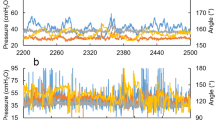Abstract
The current study aimed to refine the conventional distension model in the human rectum by measuring the cross-sectional area with a ramp-controlled impedance planimetric system. After preconditioning, the rectum in seven volunteers was distended 56 times with infusion rates of 50, 100 and 200 ml/min and at 100 ml/min during relaxation of the smooth muscle with glucagon. The pump was reversed at maximal tolerated pain. The subjects tolerated a higher volume and pressure with a more reliable sensory rating after preconditioning of the tissue. The three distension rates resulted in different pressure and tension at the maximal pain intensity (P < 0.02 and P < 0.05) with a decrease after relaxation of the smooth muscle with glucagon (P < 0.05). On the other hand, the cross-sectional area and volume were robust, did not show strain-rate dependency, and were not affected by muscle relaxation. Since the cross-sectional area is directly related to the deformation of the gut wall and hence to the strain, the study supports the idea that, independent of the muscular function, the mechano sensitive nociceptors in the human rectum depend directly on circumferential wall strain rather than on pressure and tension.
Similar content being viewed by others
References
Bochus HL: Abdominal pain. In JE Berk (ed). Gastroenterology. Philidelphia, WB Saunders, 1985, pp 22-47
van der Schaar PJ, Lamers CB, Masclee AA: The role of the barostat in human research and clinical practice. Scand J Gastroenterol (Suppl 230) 34:52-63, 1999
Whitehead WE, Delvaux M: Standardization of barostat procedures for testing smooth muscle tone and sensory thresholds in the gastrointestinal tract. The Working Team of Glaxo-Wellcome Research, UK. Dig Dis Sci 42:223-241, 1997
Sengupta JN, Gebhart GF: Gastrointestinal afferent fibers and sensation. In L. Johnson (ed). Physiology of the Gastrointestinal Tract. New York, Raven Press, 1994, pp 484-519
Gregersen H, Orvar K, Christensen J: Biomechanical properties of duodenal wall and duodenal tone during phase I and phase II of the MMC. Am J Physiol 263:G795-G801, 1992
Gregersen H, Jörgensen CS, Dall FH: Biomechanical properties in the isolated perfused porcine duodenum. An experimental study using impedance planimetry. J Gastrointes Motil 4:125-135, 1992
Yamada H: Strength of Biological Meterials. Baltimore, Williams & Wilkins, 1970
Ginzel KH: Investigations concerning the initiation of the peristaltic reflex in the guineapig ileum. J Physiol 148:75-76, 1959
Thumshirn M, Camilleri M, Choi MG, Zinsmeister AR: Modulation of gastric sensory and motor functions by nitrergic and alpha2-adrenergic agents in humans. Gastroenterology 116:573-585, 1999
Piessevaux H, Tack J, Wilmer A, Coulie B, Geubel A, Janssens J: Perception of changes in wall tension of the proximal stomach in humans. Gut 49:203-208, 2001
Distrutti E, Azpiroz F, Soldevilla A, Malagelada JR: Gastric wall tension determines perception of gastric distention. Gastroenterology 116:1035-1042, 1999
Gregersen H, Kassab G: Biomechanics of the gastrointestinal tract. Neurogastroenterol Motil 8:277-297, 1996
Gregersen H, Christensen J: Gastrointestinal tone. Neurogastroenterol Motil 12:501-508, 2000
Drewes AM, Schipper KP, Dimcevski G, Petersen P, Andersen OK, Gregersen H, et al: Multimodal assessment of pain in the esophagus: a new experimental model. Am J Physiol Gastrointest Liver Physiol 283:G95-G103, 2002
Dall FH, Jorgensen CS, Houe D, Gregersen H, Djurhuus JC: Biomechanical wall properties of the human rectum. A study with impedance planimetry. Gut 34:1581-1586, 1993
Petersen P, Gao C, Rössel P, Qvist P, Arendt-Nielsen L, Gregersen H, et al: Sensory and biomechanical responses to distension of the normal human rectum and sigmoid colon. Digestion 64:191-199, 2001
Drewes AM, Petersen P, Rossel P, Gao C, Hansen JB, Arendt-Nielsen L: Sensitivity and distensibility of the rectum and sigmoid colon in patients with irritable bowel syndrome. Scand J Gastroenterol 36:827-832, 2001
Gregersen H, Stödkilde-Jörgensen H, Djurhuus JC: The four-electrode impedance technique: a method for investigation of compliance in luminal organs. Clin Phys Physiol Meas 9(suppl A): 61-64, 1988
Gregersen H, Andersen MB: Impedance measuring system for cross-sectional area in the gastrointestinal tract. Med Biol Eng Comput 29:108-110, 1991
Dall, FH: Biomechanical properties in the rectum evaluated by means of manometry and impedance planimetry. Thesis, århus University, Denmark, 1996
Bouhassira D, Sabate JM, Coffin B, Le Bars D, Willer JC, Jian R: Effects of rectal distensions on nociceptive flexion reflexes in humans. Am J Physiol 275:G410-G417, 1998
Ford MJ, Camilleri M, Zinsmeister AR, Hanson RB: Psychosensory modulation of colonic sensation in the human transverse and sigmoid colon. Gastroenterology 109:1772-1780, 1995
Lembo T, Munakata J, Mertz H, Niazi N, Kodner A, Nikas V, et al: Evidence for the hypersensitivity of lumbar splanchnic afferents in irritable bowel syndrome Gastroenterology 107:1686-1696, 1994
Mertz H, Naliboff B, Munakata J, Niazi N, Mayer EA: Altered rectal perception is a biological marker of patients with irritable bowel syndrome. Gastroenterology 109:40-52, 1995
Munakata J, Naliboff B, Harraf F, Kodner A, Lembo T, Chang L, et al: Repetitive sigmoid stimulation induces rectal hyperalgesia in patients with irritable bowel syndrome. Gastroenterology 112:55-63, 1997
Whitehead WE, Holtkotter B, Enck P, Hoelzl R, Holmes KD, Anthony J, et al: Tolerance for rectosigmoid distention in irritable bowel syndrome. Gastroenterology 98:1187-1192, 1990
Tack J, Sifrim D: A little rest and relaxation. Gut 47:11-12, 2000
Camilleri M, Coulie B, Tack JF: Visceral hypersensitivity: facts, speculations, and challenges. Gut 48:125-131, 2001
Barlow JD, Gregersen H, Thompson DG: Identification of biomechanical factors associated with the perception of distension in the human esophagus. Am J Physiol Gastrointest Liver Physiol 282;G683-G689, 2002
Drewes AM, Pedersen J, Liu W. Arendt-Nielsen L. Gregersen H: Controlled mechanical distension of the human oesophagus sensory and biomechanical findings. Scand J. Gastroenterol 38:27-35, 2003
Gao C: Biomechanical properties and sensory nerve function in the human small intestine. Thesis. Aalborg University, Denmark, 2001
Rights and permissions
About this article
Cite this article
Petersen, P., Gao, C., Arendt-Nielsen, L. et al. Pain Intensity and Biomechanical Responses During Ramp-Controlled Distension of the Human Rectum. Dig Dis Sci 48, 1310–1316 (2003). https://doi.org/10.1023/A:1024107209436
Issue Date:
DOI: https://doi.org/10.1023/A:1024107209436




